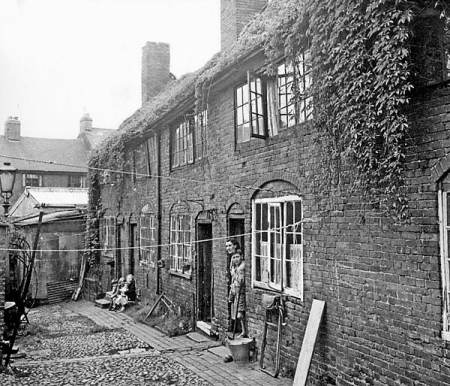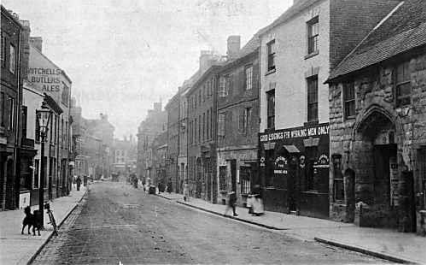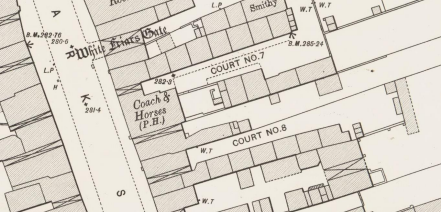CovSoc member John Marshall, chair of Stoke Local History Group, reflects on the rapid growth of court dwellings in 19th century Coventry.

The industrial population of Coventry expanded very quickly in the early years of the 19th century and, as a result, there was enormous pressure on space within the city’s creaking medieval street plan. The effect was a concentration of housing on every available piece of land.
A number of large old houses, which once had generous gardens, soon lost their outdoor space.
“Many gardens were rapidly built up with parallel rows of small dwellings, often with weavers’ workshops on their upper floors,” notes the Victoria County History. “Passages through or between the houses on the street frontages provided the only access to these crowded and often insanitary courts.”
In the forty years between 1801 and 1841, the population of Coventry almost doubled and it was not considered possible to expand the city outwards, where ancient Lammas and Michaelmas lands were protected from development.
Consequently, virtually all additional housing was squeezed into the inner city. By 1843, a report on working class housing found that conditions were very bad.
“The town possessed many very old houses,” says the County History, “some of which were timber-framed buildings with upper storeys projecting into streets which were often ‘narrow, crooked, ill-lighted, ill-paved and cleansed, and very ill-ventilated. Lanes, courts, and alleys abound in every direction and of the worst kind’.
“In these the inhabitants were so congested ‘that disease takes root in the human frame as speedily as though the locality itself were pestiferous.’ Such conditions were plentifully distributed through Coventry.”

It appears that the worst areas were places like Leicester Street, Tower Street and Palmer Lane. The neighbourhoods of Cow Lane, Warwick Lane, Greyfriars Lane, Barrack Yard, Much Park Street and St John’s Street were all neglected and unhealthy, with parts of Spon Street ‘notoriously so’.
“It is true that most tenements in Coventry were of two storeys, each house occupied by a single family. But there were many back-to-back houses in the older parts of the town where there were also three-storey buildings with one entrance and without through ventilation, each containing three or four families. A report in 1849 gives many instances of overcrowding in these areas. In Brewery Street, for example, a man, wife, five children, and four lodgers occupied one room, and this was not untypical.”
In the 1840s, even recently constructed houses left much to be desired.
“They were built as cheaply as possible with the object of getting quick returns from rents, and as many dwellings as possible were squashed on to small spaces. Often, they consisted of rows of houses 18 feet deep by 12 feet wide, the ground floor comprising a kitchen of say 12 feet by 10 feet, together with a ‘back-kitchen, pantry, coal-hole and staircase’. Above this were two bedrooms (often used for business purposes), while the upper storey was intended for a ribbon-weavers’ shop, capable of taking up to four looms.”

In his book, Coventry: Six Hundred Years of Municipal Life, Frederick Smith tells us that by 1849 a number of diseases had reached epidemic proportions, including scarlet fever and typhus, with a high level of mortality. He wrote:
“The streets were generally long, and were narrow and, mostly tortuous, and there were no less than 164 courts, alleys and yards (in many cases without any thoroughfare, and approached by long covered passages), containing in all 1,813 houses, occupied by 7,408 persons. Overcrowding was prevalent…”
Of 98 streets, some had sewers but 76 had no sewers at all. For those sewers that existed, the outlet was usually into the Sherbourne. In some places there might be one privy per house, but in others there would be one privy for seventeen houses. Of 163 courts and yards, there was an average of one privy to six houses.
These days, the Watch Museum in Spon Street occupies part of what is thought to be the last surviving court in Coventry. The museum acquired Court 7, behind the former Shakespeare pub, in 2002 with the intention of renovating the site and turning it into a permanent Watch Museum. The current museum is run by volunteers and is open twice a week. Visitors can see the old court dwellings and the outside toilets which were once so common in Coventry.
A vivid illustration of court housing can also be found in Birmingham, where the National Trust has impressively restored some remaining back-to-back houses in Hurst Street.
The original version of this article appeared in the May 2023 edition of Jabet’s Ash, the newsletter of Stoke Local History Group.
